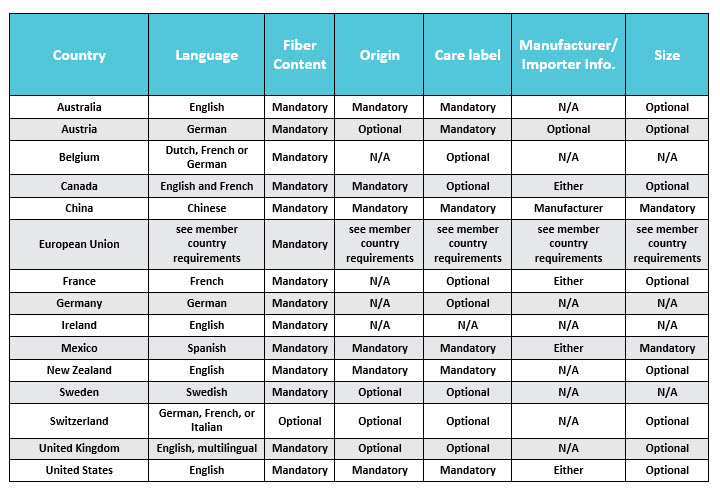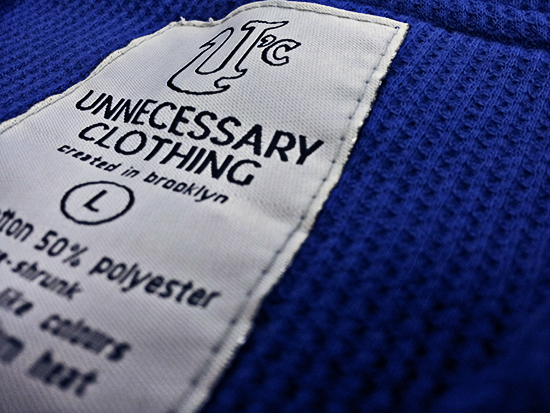42 legal requirements for clothing labels uk
Textile Labelling 2021 UK Guidance - Brexit Information The rules for what you must show on labels will stay the same. Responsibility for labelling Manufacturers and retailers will be responsible for complying with the labelling requirements. If you know that you will be placing textile products on the UK market from 1 January 2021, you should check the presence and accuracy of the labels. Product labelling: the law - GOV.UK Rules for retailers If you're a retailer, you must display: the price of products - this must be in sterling (pounds and pence) and include VAT where applicable the price of a single item (the...
Labelling of textiles – London Borough of Bromley This guidance is for England, Scotland and Wales The Textile Products (Labelling and Fibre Composition) Regulations 2012 require all textile products to carry a label indicating the fibre content....

Legal requirements for clothing labels uk
Garment Labelling Requirements for Clothing (Full Guide) Take a look at the details a label needs to include in the UK: 1. Fiber Content As part of the Government's Textile Labelling Regulations, fiber content should be clearly displayed on your label. To showcase this, you will need to include the main fiber content of your garment in percentages. For example, "100% cotton." Clothes shop legal issues | Business Law Donut Although there are no licensing requirements relating specifically to the retail sale of clothing and accessories there are certain other licences that you may need to get, depending on how your business operates. Playing music in the shop Marking, labelling and marketing standards for imports and exports - GOV.UK Marking, labelling and marketing standards for imports and exports. Marking, labelling and marketing standards you must follow to import and export plant seeds, food and manufactured goods. From ...
Legal requirements for clothing labels uk. Labelling of textiles - Business Companion This guidance is for England, Scotland and Wales The Textile Products (Labelling and Fibre Composition) Regulations 2012 require all textile products to carry a label indicating the fibre content. If a product consists of two or more components with different fibre contents, the content of each must be shown. Product Labelling Law UK | Avoid Making Misleading Labels As a retailer, the products that you are selling in the United Kingdom must display: The price in sterling (pounds and pence) and include the VAT content (if applicable). The 'unit price' of a single item for products that you are selling loose. Clothing Labels and the Law (UK & EU) - GB Labels - Beautifully British In the EU and the UK, manufacturers are legally required to state what textiles a garment is made out of. You must give an exact percentage of any material that comprises more than 15% of the total weight of the product, and every material must be listed on the label. EU - Labeling/Marking Requirements The dimensions of the label must not be less than a standard A8 sheet of paper (52 mm x 74 mm), and each symbol must cover at least one-tenth of the label's surface area. Member States may require their national language (s) to be used in the labeling of dangerous substances.
Clothing and Textiles Regulations in the European Union: A Complete Guide The GPSD outlines several requirements for importers, manufacturers, or distributors selling their products in the EU, including the following: Creation and backup of the Risk Assessment Report Creation of the Technical File Provide traceability label Obtain test reports (if applicable) Creation of the user manual for the products (if applicable) European Union Product Labeling Requirements: A Complete Guide EU Textiles Labeling. Clothing and other products containing a minimum of 80% by weight of textile fibers must be labeled with the correct fiber composition (e.g. 100% Cotton or 100% Polyester). Further, the label must be permanent, which means it must either be attached to the clothing item or printed. A sticker is not enough. Labelling and packaging FAQs | Business Law Donut Retailers must display product prices clearly, either on the label or nearby (for example, with a price indication on the shelf under the goods). Similarly, restaurants and similar businesses must show product prices on their menus. Where products are being sold to consumers, the price must usually include VAT. 11. Textile labelling - GOV.UK You must follow special rules if you manufacture, distribute or sell textiles. Labelling requirements The label must show the fibre content, including fur and other animal parts. If a product...
Textile Label - Your Europe Every textile product must be labelled or marked to show its fibre composition whenever the product is marketed in the EU. These labels must be firmly attached to the product, for example, sewn in. This requirement concerns all products made up of at least 80% of textile fibres, calculated by weight, such as: clothing furniture coverings Brexit: impact on textile labelling - Ginetex You must label the goods with your company's details, including your company's name and a contact address in the UK as of 1st January 2021. Until 31 December ... Clothing manufacturer legal issues | Business Law Donut If you plan to manufacture children's nightwear, the Nightwear (Safety) Regulations apply. Nightwear must comply with the flammability performance requirements of BS 5722 and carry the appropriate label. Further requirements for the fire safety of children's nightwear came into effect in November 2008, introduced by European standard BS EN 14878. Laws for Selling Handmade Clothing & Accessories - Made Urban LABELING REQUIREMENTS: 1) Fibre Content 2) Dealer Identity 3) Form of Label 4) Application of Label 5) Addition Information 1) FIBRE CONTENT Fibre content must be shown by its proper name and mass amount on the labels. For more details on any area covered here, you can read over the fibre content section of the Competition Bureau's guide. FIBRE
Laws on Clothing Label Requirements | Legal Beagle Labels on clothing products covered by the Textile and Wool Acts must disclose the fiber contents of the article in descending order of percentage, according to the FTC. Non-fibrous materials such as buttons and zippers do not have to be included. A five percent rule is applied for fibers without functional significance to the garment.
Ultimate Guide to the Legal Requirements of T-Shirt Relabeling Basic info required on t-shirt labels: Size: S, M, L, XL. Material (Fiber Content): i.e. 100% Cotton or 60% Cotton 40% Polyester. Manufacturer: i.e. Your Business Name. For garments made outside the United States (most products) you can use the following text for country of origin: Made in U.S.A. of imported fabric.
Laws on clothing label requirements - eHow UK The information required on clothing labels is governed under two separate laws established by the Federal Trade Commission (FTC). The Textile and Wool Acts require that labels contain three pieces of information pertaining to the garment: fibre content, country of origin, and manufacturer, importer or dealer.
Packaging (Essential Requirements) Regulations: guidance notes - GOV.UK Ref: BIS/15/460 PDF, 437KB, 18 pages Details This guide is for you if you're involved in the placing of packaged goods on the market. It explains the requirements of the Packaging (Essential...
United Kingdom food labelling regulations - Wikipedia The law in the United Kingdom on food labelling is multifaceted and is spread over many reforms and parliamentary acts.UK law is based on the relevant European Union rules, chiefly Regulation (EU) 1169/2011, which is implemented in the UK in the Food Information Regulations 2014, the Food Information (Wales) Regulations 2014, the Food Information (Scotland) Regulations 2014 and the Food ...
Garment and Textile Labelling - UKFT The basis of these Regulations is that the label must include information on the main fibre types used and their percentages - for example wool 80%, cotton 20%. The information given must be understandable by a consumer in the market in to which you are selling. It is not sufficient just to use English if you are exporting to the EU.
Brexit Labelling Guidance - Food and Product Labels after Brexit New Rules for Labelling are here. Legal requirements for labels and stickers have changed as a result of the UK's departure from the European Union and the new free trade agreement. Some changes must be made immediately, while others are being phased in over time. Crown Labels are working hard to provide an overview of labelling updates to help ...

Everything you need to know about Canadian and US clothing label requirements — All Sorts Creative
[Withdrawn] Textile products labelling guidance - GOV.UK Guidance for business on EU and UK textile labelling regulations, defining common terms and descriptions for wool and other textiles. From: Department for Business, Energy & Industrial Strategy...
Are Care Labels a Legal Requirement? - Business Services Week UK For such a small label, there are four areas of information that are required to be displayed: Fibre Content Mandatory for care labels in the UK, the fibre content of textiles must include information on the main fibre types used along with the percentages. The information must be easily understandable to the consumer, eg 80% wool, 20% cotton.
TEXTILE LABELLING REGULATIONS - Guidance Notes Regulation and the UK Regulations. However, they do not carry any legal authority and should be read in conjunction with the legislation itself.
Your guide to Care Labels for your garments - GB Labels If the garment does meet this standard, the label requires KEEP AWAY FROM FIRE to be clearly displayed on the label in an Arial font at least pt.10 in size in capital letters and in bold AND red.
Product Labeling Regulations in the US, EU and Australia A label can, for example, inform the customer about the following: The manufacturing country; If the product meets certain legal safety requirements (i.e., compliance marks) Size, material and other general product information; Warning labels and user instructions; Some labeling requirements apply to all, or a wide range of, product categories.
Marking, labelling and marketing standards for imports and exports - GOV.UK Marking, labelling and marketing standards for imports and exports. Marking, labelling and marketing standards you must follow to import and export plant seeds, food and manufactured goods. From ...
Clothes shop legal issues | Business Law Donut Although there are no licensing requirements relating specifically to the retail sale of clothing and accessories there are certain other licences that you may need to get, depending on how your business operates. Playing music in the shop
Garment Labelling Requirements for Clothing (Full Guide) Take a look at the details a label needs to include in the UK: 1. Fiber Content As part of the Government's Textile Labelling Regulations, fiber content should be clearly displayed on your label. To showcase this, you will need to include the main fiber content of your garment in percentages. For example, "100% cotton."














Post a Comment for "42 legal requirements for clothing labels uk"